Peruvian culture is the gradual blending of Amerindian cultures with European and Asian ethnic groups. The ethnic diversity and rugged geography of Peru allowed diverse traditions and customs to co-exist. Peruvian culture has been deeply influenced by Native culture, Spanish culture, and Asian culture. Other minor influences on their culture are Chinese, Japanese, and other European peoples.

The National University of San Marcos is a public research university located in Lima, the capital of Peru. In the Americas, it is the first officially established and the oldest continuously operating university.

The Historic Centre of Lima is the historic city centre of the city of Lima, the capital of Peru. Located in the city's districts of Lima and Rímac, both in the Rímac Valley, it consists of two areas: the first is the Monumental Zone established by the Peruvian government in 1972, and the second one—contained within the first one—is the World Heritage Site established by UNESCO in 1988, whose buildings are marked with the organisation's black-and-white shield.

La Victoria is one of the forty-three districts that make up the province of Lima, located in Peru. It borders to the north and northeast with the district of Lima, to the east with the district of San Luis, to the southeast with the district of San Borja, to the south with the district of San Isidro, and to the west with the district of Lince and again with the Lima district. La Victoria is a historical and very busy public district located in downtown Lima. The current mayor of La Victoria is Rubén Dioscorides Andrés Cano Altez.
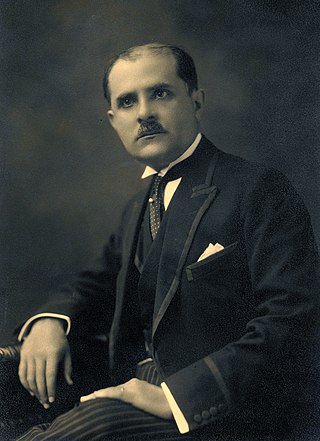
Luis Antonio Eguiguren Escudero was a Peruvian educator, magistrate, historian and politician. He was the director of the General Archive (File) of the Nation (1914), Alderman of Lima (1914–1920), Mayor of Lima (1930), President of the Constituent Congress (1930–1932), founder and leader of the Peruvian Social Democratic Party. He won the Peruvian presidential election of 1936, but his victory was ignored by the Congress and the then-President Oscar R. Benavides, who claimed that he had won with votes of the APRA. He presided over the Supreme Court and the Judiciary in 1953 and 1954.
Peruvian art has its origin in the Andean civilizations. These civilizations rose in the territory of modern Peru before the arrival of the Spanish.

Marco Aurelio Denegri Santa Gadea was a Peruvian intellectual, literary critic, television host and sexologist.
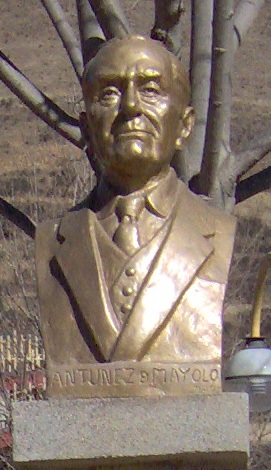
Santiago Antúnez de Mayolo was born on 10 January 1887 in the country estate of Vista Bella, province of Aija, Peru, department of Áncash. He was an engineer, physicist and mathematician.
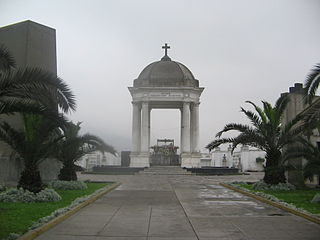
Presbyter Matías Maestro Cemetery, formerly the General Cemetery of Lima, is a cemetery, museum and historical monument located in the Barrios Altos neighbourhood of Lima District, in Lima, Peru. Inaugurated on May 31, 1808, it was the first pantheon in the city since burials were previously held in the city's churches. It was named in honour of its designer, Spanish priest Matías Maestro.

Jorge Alfredo Basadre Grohmann was a Peruvian historian known for his extensive publications about the independent history of his country. He served during two different administrations as Minister of Education and was also director of the Peruvian National Library.

The Plaza San Martín is one of the most representative public spaces of the city of Lima, Peru. It is located at the ninth block of Colmena avenue, within the Historic Centre of Lima which was declared a World Heritage Site in 1988 by UNESCO. It is located near the Plaza Mayor of Lima and is connected to it by the Jiron de la Union. Its central monument gives homage to Peru's liberator, José de San Martín.
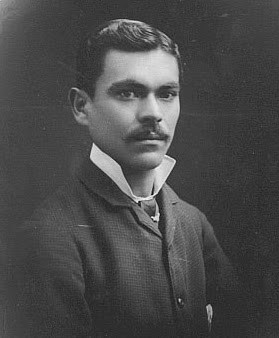
Carlos Wiesse Portocarrero (1859–1945) was a Peruvian scholar and historian. He was born in Tacna on September 4, 1859 and died in Lima on June 17, 1945. His parents were Carlos Wiesse and Jesús Portocarrero.
The Ligas Departamentales are one of two leagues that form part of the Departamental Stage in the Copa Perú of the Peruvian Football Federation (FPF) football league system. The other league at level are the Ligas Superiores.
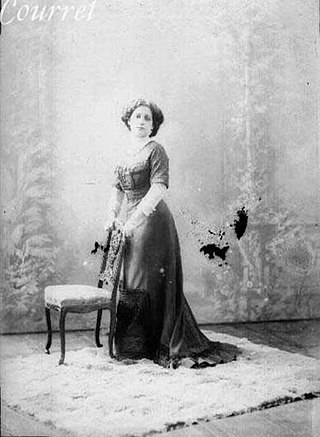
Esther Festini was a Peruvian educator. She was the first woman that went to the Universidad Nacional Mayor de San Marcos and the first one that received a Doctor of Letters.
Wilmar Elar Valencia Pacheco is a Peruvian football manager and former player who played as a central defender.
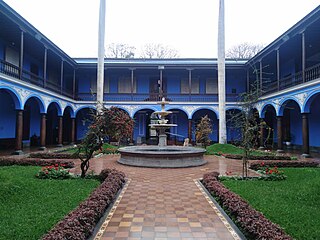
The Real Convictorio de San Carlos, or Convictorio de San Carlos after independence, was a college in Lima created at the end of the Viceroyalty of Peru and which survived until the first decades of the Peruvian Republic.

Isabel María Povea Moreno is a Spanish historian who has specialized in social history and mining history of Spanish America, with special emphasis on the history of women in colonial mining.

Jirón Áncash is a major street in the Damero de Pizarro, located in the historic centre of Lima, Peru. The street starts at its intersection with the Jirón de la Unión at the Puente de Piedra, and continues until it reaches the Óvalo de la Paz.

Santa Beatriz is a neighbourhood in Lima District. It is the southernmost area of the district. It limits to the north, with the historic centre of Lima; to the east, with La Victoria; to the south, with Lince; and to the west, with Jesús María.
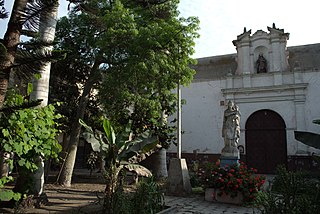
The Royal Hospital of Saint Andrew, originally known as the Hospital of Our Lady of the Conception, was a hospital in the neighbourhood of Barrios Altos, part of the historic centre of Lima, Peru.


















